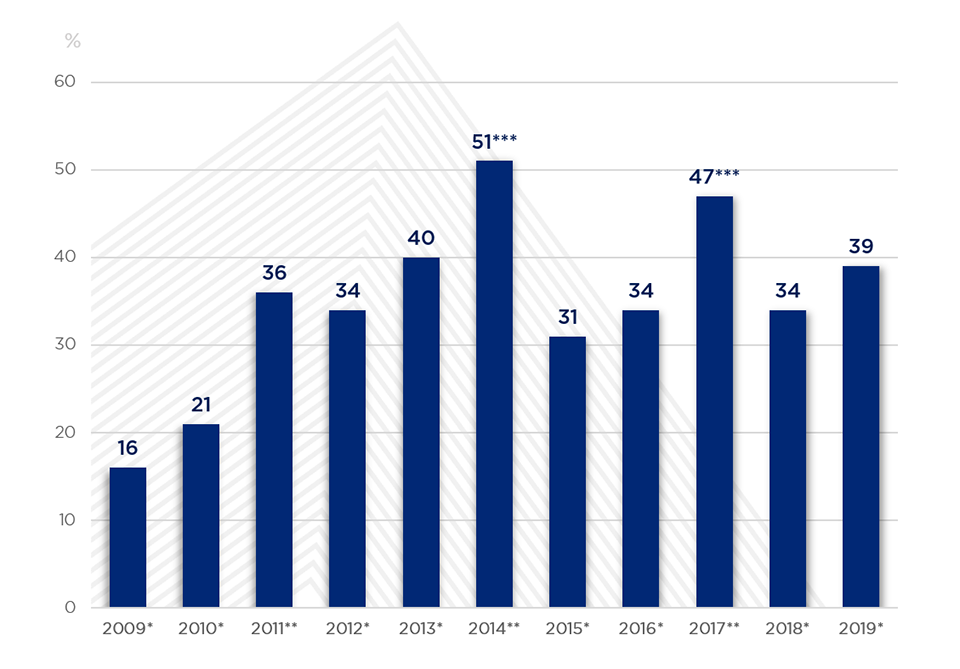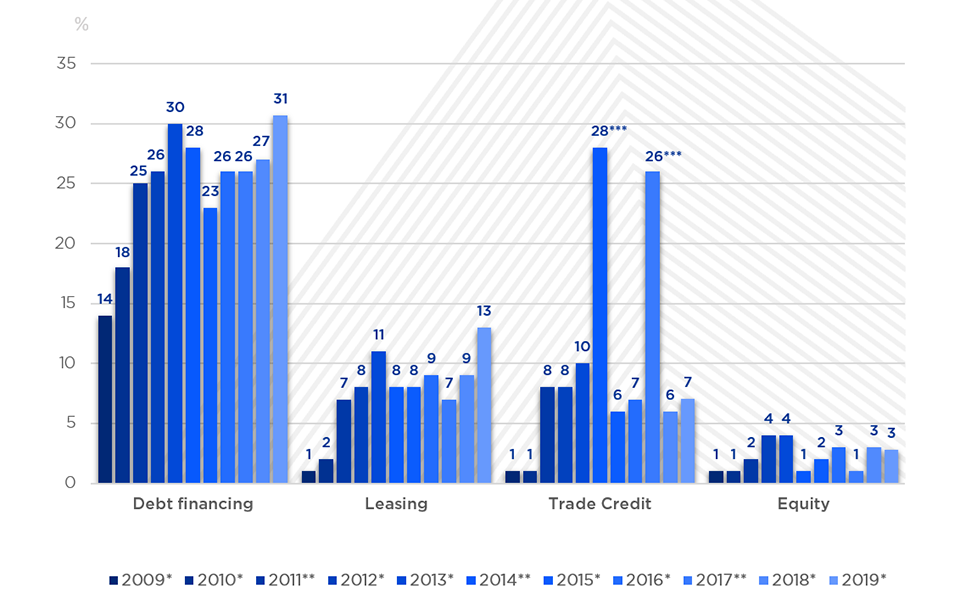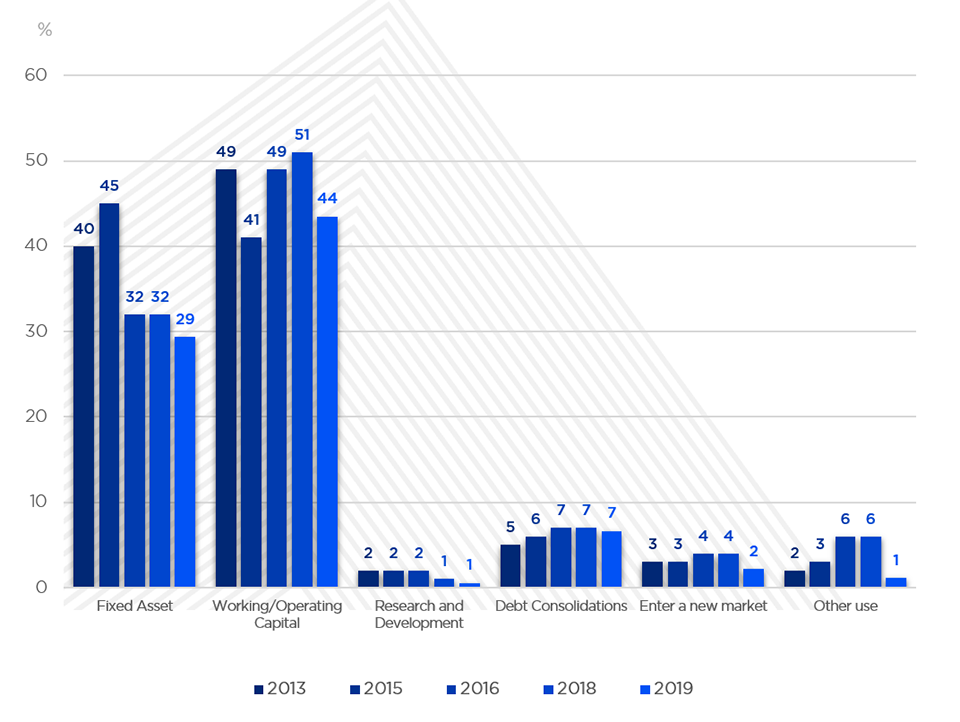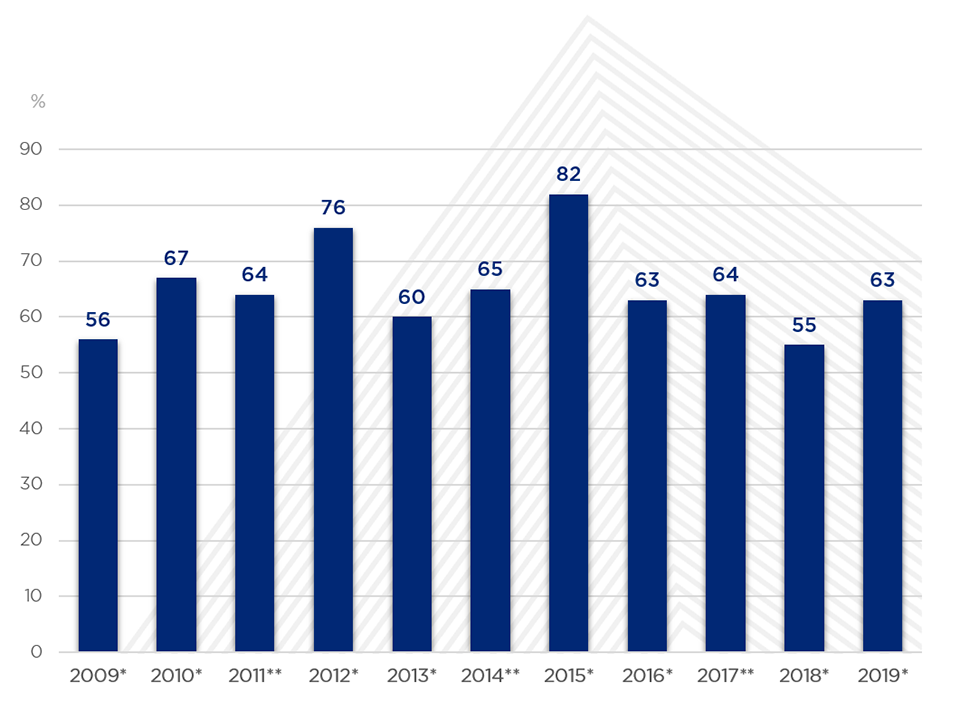Innovation, Science and Economic Development Canada
Small Business Branch
Research and Analysis Directorate
July 2020
Table of contents
- About the survey
- Overview
- External financing needs
- Reasons for seeking/not seeking financing
- Access to debt financing
- Interest rates
- Collateral rates
- Access to debt financing by type of business
- Financial glossary of Credit Conditions Survey
About the survey
Innovation Science and Economic Development Canada (ISED) maintains close contact with the small business community as part of its monitoring and data collection activities. Since 2009, ISED has managed various surveys on the borrowing activities of small businesses. Two in particular include the Credit Conditions Survey (CCS)Footnote 1 and the larger Survey on Financing and Growth of Small and Medium Enterprises (SFGSME)Footnote 2, which is conducted every three years and also surveys medium-sized businesses. The CCS is implemented in years when the SFGSME is not conducted. These surveys monitor small and medium-sized enterprises (SMEs) to provide key information on small-business-lending conditions to the business community, lenders, policy makers and academics. This analysis presents the credit conditions of small businesses in 2019, prior to the COVID-19 pandemic that started in March 2020 in Canada. The results do not take into account the economic consequences of the pandemic. The Government of Canada is committed to monitoring the credit conditions of 2020, including with the next iteration of the Statistics Canada's Survey on Financing and Growth of Small and Medium Enterprises 2020.
Overview
- In 2019, about 39 percent of small businesses requested external financing and 31 percent requested debt financing.
- In general, credit conditions for small businesses remained favourable in 2019 as 89 percent of the dollar amount of debt financing requested by businesses was authorized.
- Debt financing was more often requested by and approved for larger firms.
- The main intended used of debt financing was for working or operating capital (44 percent).
External financing needs
In 2019, 39 percent of small businesses requested external financing (debt, lease, equity, trade credit, and/or government financing), a five percentage points increase from 2018 (Figure 1).
Figure 1: Request rates for external financing

Sources: * ISED, Credit Conditions Survey, 2009, 2010, 2012, 2013, 2015, 2016, 2018 and 2019; and ** Statistics Canada, Survey on Financing and Growth of Small and Medium Enterprises, 2011, 2014 and 2017.
Note: *** Due to a change to clarify the trade credit question in the 2014 and 2017 surveys, the request rates for external financing in 2014 and 2017 are not comparable with those in the other years.
About 31 percent of small businesses requested debt financing (mortgages, term loans, lines of credit, and/or credit cards), a slight increase from 2018 (Figure 2).
Figure 2: Request rates by type of external financing

Sources: * ISED, Credit Conditions Survey, 2009, 2010, 2012, 2013, 2015, 2016, 2018 and 2019; and ** Statistics Canada, Survey on Financing and Growth of Small and Medium Enterprises, 2011, 2014 and 2017.
Note: *** Due to a change to clarify the trade credit question in the 2014 and 2017 surveys, the request rates for external financing in 2014 and 2017 are not comparable with those in the other years.
Reasons for seeking/not seeking financing
Most small businesses that requested debt financing in 2019 intended to use it to support day-to-day working and operational capital expenditures (44 percent) or to purchase or maintain fixed assets (29 percent) (Figure 3).
In 2019, 7 percent of the small businesses that requested debt financing intended to use it to consolidate debt, 2 percent to enter a new market, and 1 percent to support research and development (R&D).
Figure 3: The main reasons small businesses requested debt financing

Source: ISED, Credit Conditions Survey, 2009, 2010, 2012, 2013, 2015, 2016, 2018 and 2019.
In 2019, 88 percent of small businesses that did not seek external financing did not need financing (Table 1). Around 2 percent of non-seeking small businesses did not request financing because they considered the cost to be too high.
| Reason | 2010Footnote * (%) | 2011Footnote ** (%) | 2012Footnote * (%) | 2013Footnote * (%) | 2014Footnote ** (%) | 2015Footnote * (%) | 2016Footnote * (%) | 2017Footnote ** (%) | 2018Footnote * (%) | 2019Footnote * (%) |
|---|---|---|---|---|---|---|---|---|---|---|
| Financing not needed | 89 | 88 | 86 | 86 | 88 | 89 | 85 | 91 | 85 | 88 |
| Thought request would be turned down | 3 | 3 | 4 | 3 | 2 | 3 | 4 | 1 | 4 | 2 |
| Applying for financing is too difficult | 3 | 2 | 5 | 2 | 2 | 2 | 4 | 2 | 4 | 2 |
| Cost of financing too high | 2 | 1 | 2 | 2 | 1 | 2 | 2 | 1 | 5 | 2 |
Access to debt financing
In general, credit conditions for small businesses remained favourable in 2019 (Table 2).
| Year | Request rate (%) | Approval rate (%) | Authorized-to-requested ratio (%) |
|---|---|---|---|
| 2009Footnote * | 14 | 79 | 72 |
| 2010Footnote * | 18 | 88 | 88 |
| 2011Footnote ** | 25 | 88 | 90 |
| 2012Footnote * | 26 | 89 | 90 |
| 2013Footnote * | 30 | 85 | 89 |
| 2014Footnote ** | 28 | 81 | 83 |
| 2015Footnote * | 23 | 88 | 93 |
| 2016Footnote * | 26 | 82 | 86 |
| 2017Footnote ** | 26 | 87 | 93 |
| 2018Footnote * | 27 | 83 | 88 |
| 2019Footnote * | 31 | 89 | 89 |
The approval rate was 89 percent in 2019, the highest rate obtained since 2012. The ratio of total funds authorized-to-requested was 89 percent in 2019, consistent with recent years and well above the 2009 recessionary levels (72 percent).
Interest rates
Price conditions for debt financing eased in 2019. The average interest rate on debt financing decreased 0.4 percentage point to reach 5.3 percent in 2019 (Table 3). Over the same period, the business prime rate increased 0.1 percentage point to reach 3.6 percent. The risk premium, a measure of lenders' risk perception, decreased by 0.5 percentage point to reach 1.7 percent, the lowest level since 2009.
| Interest rate | 2009Footnote * (%) | 2010Footnote * (%) | 2011Footnote ** (%) | 2012Footnote * (%) | 2013Footnote * (%) | 2014Footnote ** (%) | 2015Footnote * (%) | 2016Footnote * (%) | 2017Footnote ** (%) | 2018Footnote * (%) | 2019Footnote * (%) |
|---|---|---|---|---|---|---|---|---|---|---|---|
| Interest rate, average | 6.2 | 5.8 | 5.3 | 5.4 | 5.6 | 5.2 | 5.1 | 5.3 | 5.4 | 5.7 | 5.3 |
| Interest rate, business primeFootnote *** | 3.1 | 2.6 | 3.0 | 3.0 | 3.0 | 3.0 | 2.9 | 2.8 | 2.9 | 3.5 | 3.6 |
| Risk premium | 3.1 | 3.2 | 2.3 | 2.4 | 2.6 | 2.2 | 2.2 | 2.5 | 2.5 | 2.2 | 1.7 |
| Note: Interest rates charged for credit cards are excluded. | |||||||||||
Collateral rates
Lenders required collateral on more loans. About 63 percent of small businesses were required to pledge collateral in 2019, an increase from 55 percent in 2018 (Figure 4).
Figure 4: Collateral rates for debt financing

Source: * ISED, Credit Conditions Survey, 2009, 2010, 2012, 2013, 2015, 2016, 2018 and 2019; and ** Statistics Canada, Survey on Financing and Growth of Small and Medium Enterprises, 2011, 2014 and 2017.
Access to debt financing by type of business
Debt financing request rates positively correlate to size of business (Table 4). In 2019, 24 percent of businesses with 1–4 employees requested debt financing compared to 32 percent of businesses with 5–19 employees and 46 percent of businesses with 20–99 employees.
Approval rates were highest among businesses with 20–99 employees in 2019. About 97 percent of business debt-financing requests with 20–99 employees were approved. Micro-businesses (those with 1–4 employees) continued to face greater difficulties in accessing financing.
| 2019 | Request rate (%) | Approval rate (%) |
|---|---|---|
| Source: ISED, Credit Conditions Survey, 2019. | ||
| All small businesses (1–99 employees) | 31 | 89 |
| Employment size | ||
| 1–4 employees | 24 | 84 |
| 5–19 employees | 32 | 88 |
| 20–99 employees | 46 | 97 |
| Export | ||
| Exporter | 35 | 90 |
| Non-exporter | 31 | 88 |
| Age of business | ||
| 2 years old or younger | 39 | 85 |
| 3 to 10 years old | 38 | 87 |
| 11 to 20 years old | 26 | 89 |
| More than 20 years old | 30 | 90 |
| Innovation activities developed or introduced | ||
| Innovator | 40 | 87 |
| Non-innovator | 22 | 92 |
Debt financing request rate is highest for start-ups (2 years old or younger). Thirty-nine percent of them request debt financing in 2019, compared to 30 percent for businesses that are more that 20 years old. The average approval rate for start-ups (85 percent) is 5 percentage points less than for older businesses (90 percent).
Small business exporters and innovators were more likely to request financing than non-exporters (35 percent versus 31 percent) and non-innovators (40 percent versus 22 percent) in 2019. The approval rate for exporters was 90 percent, compared to 88 percent for non-exporters. However, there is no evidence that innovators were better able to access financing. Approval rates for innovators (87 percent) were lower than for non-innovators (92 percent).
Financial glossary of Credit Conditions Survey
- Approval rate
- The ratio between the number of firms approved (fully or partially) for financing and the number of firms that requested financing.
- Authorized-to-requested rate
- The ratio between total amount of loans authorized by lenders and total amount of loans requested by borrowers.
- Business risk premium
- The business risk premium is the difference between the average small business interest rate and the business prime rate (the rate charged to the most creditworthy borrowers).
- Collateral
- An asset pledged by a borrower to a lender, usually in return for a loan. The lender has the right to seize the collateral if the borrower defaults on the obligation.
- Collateral rate
- The percentage of firms required to provide collateral to secure their loans.
- Debt financing
- A type of financing used to collect funds through the form of borrowing debt such as mortgages, term loans, lines of credit, and/or credit cards.
- Equity financing
- A type of financing used to collect funds by selling equity such as shares/ownership of the business entities.
- External financing
- The phase of financing used to describe funds that business entities obtain from outside their business; the funds can be obtained through various forms/sources such as debt, lease, equity, trade credit and government financing.
- Financing
- The act of providing or raising funds for business activities, making purchases or investing.
- Lease financing
- A type of financing used to collect funds through the form of lease.
- Line of credit
- An arrangement that a financial institution extends an amount of credit to a business entity.
- Mortgage
- A debt instrument secured by the collateral of specified real estate property that the borrower is obliged to pay back with a predetermined set of payments.
- Price and non-price conditions
- A financing condition measured by the pricing factors such as loan rates, mortgage rates, and credit card rates; and, a financing condition measured by the non-pricing factors such as collateral rates, leasing terms, and trade credit payment and discount days.
- Term loan
- A monetary loan that is repaid following a specific repayment schedule and a fixed or floating interest rate.
- Trade credit
- An agreement where a business entity can obtain and/or consume goods and services in advance, and pay the suppliers at a later date.
- Request rate
- The ratio between the number of firms that requested financing and the total number of firms.
This analysis was prepared by the Small Business Branch.
The Research and Analysis directorate brings you the latest research and exclusive statistics on SMEs in Canada. For all questions or comments, contact our team at ic.mediarelations-mediasrelations.ic@canada.ca.
The data used for the purpose of this analysis is also available on ic.gc.ca/smeresearch.

